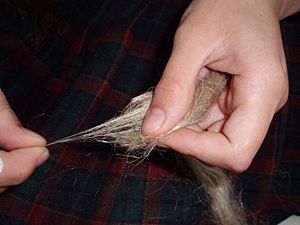Short draw facts for kids
Short draw is a special way to make yarn. It's a spinning technique that helps create strong, smooth yarns called worsted yarns. When you use short draw, the fibers in your yarn are all lined up neatly, side by side. This method usually works best with long fibers, like certain types of wool.
Yarns made with short draw are very smooth, strong, and dense. They don't stretch much, which makes them great for weaving fabric. This technique is often compared to the long draw method, which makes fluffier, woolen yarns.
Contents
How the Technique Works
The short draw method has two main rules. First, the spinner keeps their hands close together. They are only a little bit farther apart than the length of the fiber they are spinning. Second, the twist in the yarn stays between the hand closer to the spinning wheel and the wheel itself. No twist ever gets between the two hands.
There are a few ways to do short draw, depending on which hand does most of the work.
Forward Short Draw
In this method, the hand closer to the spinning wheel is the "active" hand. The other hand, called the "passive" hand, stays still. It gently holds the fibers in a triangle shape, which is called the drafting triangle.
The active hand moves forward to pull out a small amount of fibers from the triangle. Then, it moves back. As it moves back, the twist from the wheel is allowed to enter the new yarn. This helps make the yarn strong and even. The twist never goes between the two hands. Once the active hand is back, the process repeats.
Backward Short Draw
For backward short draw, the hand closer to the wheel is the "passive" hand. This hand pinches the new fibers. The hand farther from the wheel is the "active" hand. It pulls the fibers out as it moves backward. Once the fibers are pulled out, the active hand moves forward. This lets the twist enter the new yarn as it passes through the passive hand.
Combination Short Draw
The difference between forward and backward short draw is just which hand is doing the main work. In both, one hand is active, and the other is passive. The combination short draw uses both hands as active and passive at different times.
Getting Fibers Ready
To spin with the short draw method, fibers are usually prepared by combing. Combing lines up the long fibers perfectly, which is ideal for short draw. After combing, the fibers can be made into a sliver or a roving. A sliver is just the combed fibers, while a roving has a slight twist to hold the fibers together. You can also spin directly from the combed fibers.
Sometimes, people use carded fibers, like rolags, for short draw. However, this doesn't make a true worsted yarn because the fibers aren't all perfectly parallel. But if you use a drum carder, it can line up the fibers well. This allows you to create a proper worsted yarn with the short draw technique.
Using Short Draw
Short draw is often one of the first spinning methods people learn. It's simpler than long draw and helps new spinners make even yarn more easily. However, many experienced spinners use a mix of short draw and long draw techniques. For example, a spinner might let the twist get between their hands, which is part of long draw. Even if they follow other short draw rules, it's not strictly short draw anymore. Short draw is very common because many spinners don't know how to do the long draw technique.
Because short draw yarns don't stretch much, they are excellent for weaving. They are especially good for the warp, which are the strong threads that run lengthwise on a loom. They are not as good for knitting because the yarn doesn't fluff up as much. But, they do make knitted stitches look very clear and defined.
The first spinning machines were designed based on the short draw method. Instead of hands, they used rollers that moved at different speeds to pull and twist the fibers. Even today, many modern spinning machines still use this same idea. The fibers in the yarn are parallel, and there's no twist where the fibers are being pulled.


